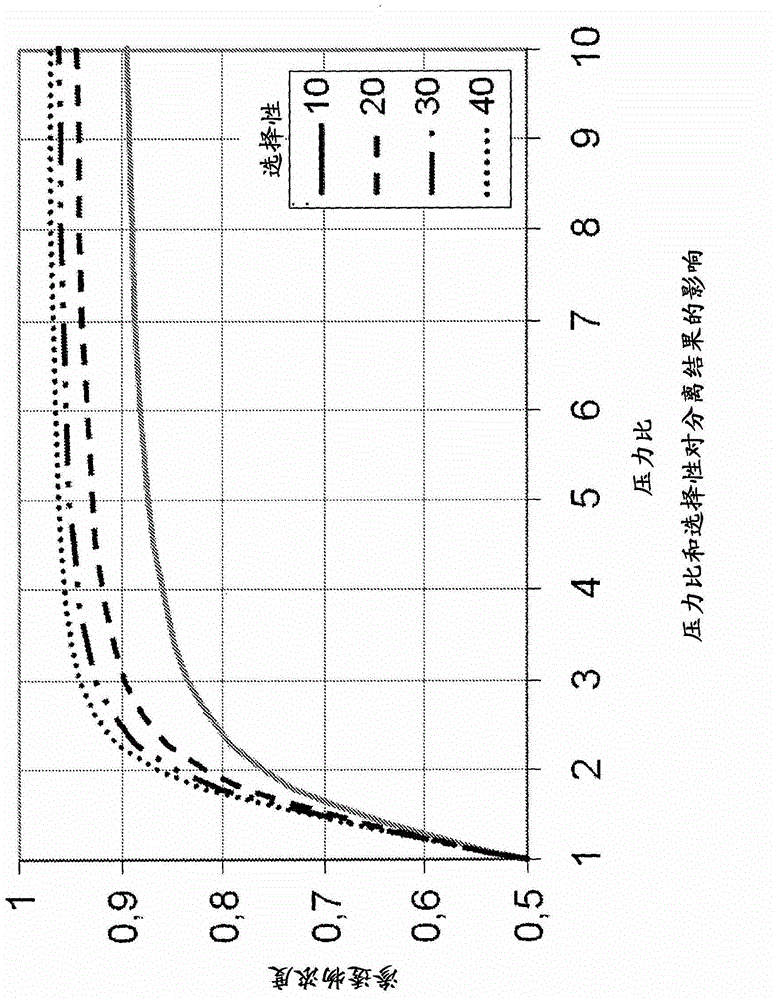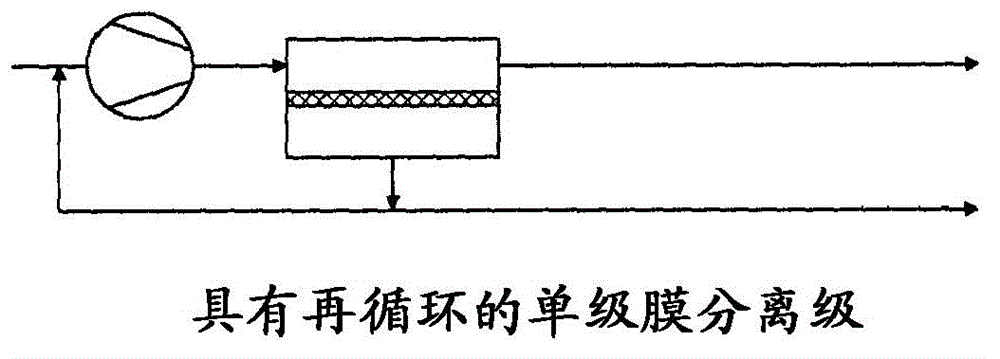Process for separation of gases
A technology for separating gas and membrane separation, applied in separation methods, gas fuel, gas treatment, etc.
- Summary
- Abstract
- Description
- Claims
- Application Information
AI Technical Summary
Problems solved by technology
Method used
Image
Examples
Embodiment 1
[0077] Example 1: Separation of a mixture of methane and carbon dioxide with a mixing ratio of 50:50 using a highly selective polyimide membrane
[0078] use Figure 11 connections shown. Each stage is composed of hollow fiber membrane modules with about 5m 2 The separation area of the components / components is constructed of highly selective hollow polyimide fibers. These hollow polyimide fibers were prepared according to example 19 of Austrian patent application A1164 / 2009, but where operating with a precipitation bath temperature of 40°C instead of 10°C. will be 1m 3 A raw gas mixture of 50% methane and 50% carbon dioxide per h (which roughly corresponds to the gas mixture of biogas) is introduced into the mixing chamber and then compressed to 25 bar together with the recycle gas consisting of streams 9 and 10. The gas, which has been compressed and cooled to 20° C., is applied to feed stream separation stage 1 . The retentate of this stage is fed to the retentate sep...
Embodiment 2
[0080] Example 2: Separation of a mixture of methane and carbon dioxide with a mixing ratio of 50:50 using a highly selective polyimide membrane with a methane content of less than 0.5% in the permeate stream
[0081] In order to meet the requirements of various legislators, the loss of methane to the atmosphere must be kept as low as possible. use Figure 11 The connection shown is to reduce the concentration of methane in the third permeate stream 11 to less than 0.5% by volume. Each stage is composed of hollow fiber membrane modules with about 5m 2 Highly selective polyimide composition of / component separation area. These hollow polyimide fibers were prepared according to example 19 of Austrian patent application A1164 / 2009, but where operating with a precipitation bath temperature of 40°C instead of 10°C. will be 1m 3 A raw gas mixture of 50% methane and 50% carbon dioxide per h (which roughly corresponds to the gas mixture of biogas) is introduced into the mixing cha...
Embodiment 3
[0083] Example 3: Separation of methane and carbon dioxide with a 50:50 mixture by means of a vacuum pump for the permeate of stage 2 with a highly selective polyimide membrane at a methane content of less than 0.5% in the permeate stream mixture of ratios
[0084] In order to meet the requirements of various legislators, the loss of methane to the atmosphere must be kept as small as possible. use Figure 11 connections shown (supplemented with Figure 11 vacuum pump not shown) to reduce the concentration of methane in the third permeate stream 11 to less than 0.5% by volume. Each stage is composed of hollow fiber membrane modules with about 5m 2 The separation area of the components / components is constructed of highly selective hollow polyimide fibers. These hollow polyimide fibers were prepared according to example 19 of Austrian patent application A1164 / 2009, but where operating with a precipitation bath temperature of 40°C instead of 10°C. will be 1m 3 A raw gas mi...
PUM
 Login to View More
Login to View More Abstract
Description
Claims
Application Information
 Login to View More
Login to View More - R&D
- Intellectual Property
- Life Sciences
- Materials
- Tech Scout
- Unparalleled Data Quality
- Higher Quality Content
- 60% Fewer Hallucinations
Browse by: Latest US Patents, China's latest patents, Technical Efficacy Thesaurus, Application Domain, Technology Topic, Popular Technical Reports.
© 2025 PatSnap. All rights reserved.Legal|Privacy policy|Modern Slavery Act Transparency Statement|Sitemap|About US| Contact US: help@patsnap.com



